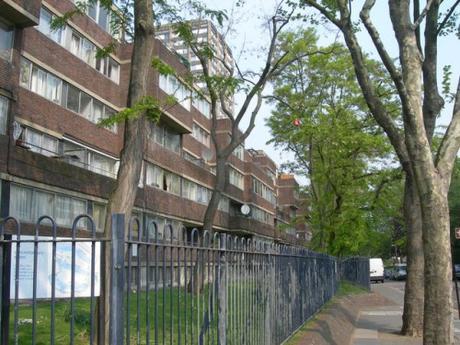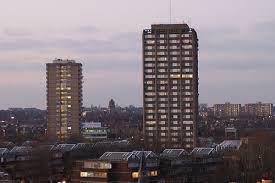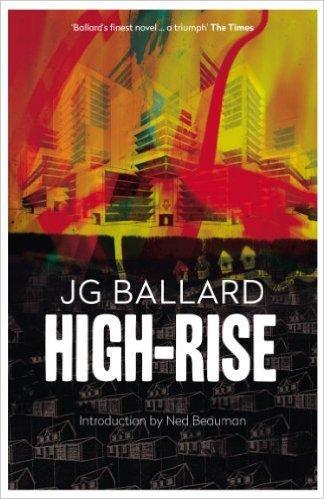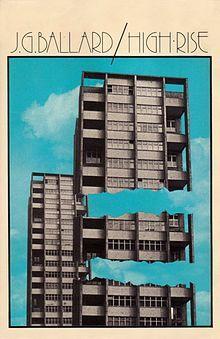High-Rise, by J.G. Ballard
I grew up in Ballardia, more specifically on the Lancaster West Estate (which looks a hell of a lot nicer now than it did back then). Lancaster West is a large low-rise council estate with a couple of high-rises embedded within it, not far from the Westway which famously inspired Concrete Island. Ballard’s landscape is the landscape of my childhood.


The odd thing is like many writers whose name became an adjective I’ve actually read far less by Ballard than it feels like I have. His work is familiar to me both from life and from his particular stylistic consistency. Perhaps that’s why it took the release of a movie based on High-Rise by one of my favorite contemporary directors to prompt me to finally actually read it.
(That’s the cover I have and the first edition cover.)
High-Rise opens with the wonderfully disquieting words I’ve used as the title for this piece. It moves swiftly into flashback, with the early tenants moving into a new high-rise development. Among them is Laing, a psychiatrist (his name clearly a shout-out to then fashionable psychiatrist R.D. Laing).
The high-rise is the first of five in its development. It’s supremely modern. Its occupants are resolutely middle class or desirably glamorous: doctors; dentists; academics; tv producers; air hostesses; actors. In real life those of us who grew up on the estates were the urban poor, here Ballard inverts that. Here the architect lives in the building he designed.
The first sign that everything is perhaps not as it should be is when a champagne bottle falls from a party on a floor above and shatters on Laing’s balcony while he’s sunbathing. The more disturbing sign is his reaction:
After breakfast, Laing cleared the glass from the balcony. Two of the decorative tiles had been cracked. Mildly irritated, Laing picked up the bottle neck, still with its wired cork and foil in place, and tossed it over the balcony rail. A few seconds later he heard it shatter among the cars parked below.
Laing is annoyed that those above him pay no regard to his safety, but he pays no more regard to those below him. He doesn’t realize the implications yet, but the high-rise has become a microcosm of wider British society. Those on the topmost floors have their own dedicated entrance lobby and high-speed lifts (a common feature today in buildings with shared occupancy between rich and merely affluent). Everyone else rubs along as best they can, eyes rarely meeting.
This central two-thirds of the apartment building formed its middle class, made up of self-centred but basically docile members of the professions – the doctors and lawyers, accountants and tax specialists who worked, not for themselves, but for medical institutes and large corporations. Puritan and self-disciplined, they had all the cohesion of those eager to settle for second best.
The lower floors house the newer professions and occupations. the ones who work on tv behind the camera; the air hostesses. They tend to be younger than those on the upper floors, many have school age children while those higher up being older now have dogs instead.
Names here are meaningful. A key character from the lower floors is tv documentary maker Richard Wilder. He’s a larger than life hard-drinking womaniser seemingly modelled on Oliver Reed (and played brilliantly in the recent film by Luke Evans who seems to be channeling Oliver Reed’s spirit). Right at the very top is architect Anthony Royal (A Royal…). The two men epitomise the class conflict inherent in the building’s structure, with firmly middle class Laing caught squarely between them cosying up to Royal and slightly fearing Wilder.
It’s a mistake with Ballard to look for psychological depth. His characters are pawns of psycho-social forces quite beyond them, and Ballard doesn’t aim for naturalism. He’s exploring here the psychology of the underlying fascism of the everyday, as he does in so many of his books.
The high-rise becomes a pressure cooker bringing out the already implicit violence of the social order. Those on top resent those down below for their noisy lives and numerous children. Those at the bottom resent those at the top for their condescension and air of entitlement. Those between try to maintain strict proprieties while jealously guarding their own possessions and territory.
Before long a famous actress’s dog is drowned in the tenth floor swimming pool during a power cut. The pool has become a flashpoint of tensions between the classes, the upper floors wanting to bar the children from using it so their pool parties aren’t interrupted. Not long after a jeweller falls from the top floor to his death, or perhaps was pushed. Nobody calls the police.
The building’s structures start to break down. Power cuts become commonplace; the bin chutes become clogged and rubbish starts to pile up around them; the area around the high-rise becomes covered in broken glass and refuse thrown from above. All of that is obviously something of a comment on 1970s’ Britain generally, but it’s also all familiar to me from the estate I actually grew up in (though Ballard takes it all to an illustrative extreme far beyond mere reality).
People band together according to their floors and carry out raids on those above and below them for food or retribution. Increasingly nobody goes outside, and most tellingly nobody calls for help (partly because that would destroy the concept of the novel, and partly because while it may seem that the social compact is breaking down in fact they’re hammering out a new compact forged from “spasms of cold and random aggression.”)
At risk of biographical detail, it’s hard to read all this without remembering Ballard’s own childhood experience of social breakdown in occupied wartime Shanghai. In his own words “I don’t think you can go through the experience of war without one’s perceptions of the world being forever changed. The reassuring stage set that everyday reality in the suburban west presents to us is torn down; you see the ragged scaffolding, and then you see the truth beyond that, and it can be a frightening experience.”
High-Rise shows us what sits under the ragged scaffolding. Early on Wilder sees his neighbours emerge from the lifts “aggressively like bad-tempered miners emerging from their pit-cages. They strode past him, briefcases and handbags wielded like the instruments of an over-nervous body armor.” At this point they’ve merely suffered some inconvenience, but the suppressed violence is already starting to show. Later they move “into a realm of no social organization at all”, forming “small groups of killers, solitary hunters who built man-traps in empty apartments or preyed on the unwary in deserted elevator lobbies.”
The inhabitants, free now to enjoy the “perversities created by the limitless possibilities of the high-rise”, are becoming who they always were. Once the new equilibrium forms, with those able to adapt having done so and those not dead, a new civil order begins to emerge. After the initial explosion of violence and monstrosity the new barbarism looks suspiciously like where everybody started, save with tasteful wallpaper replaced with fire pits and spit-roast Alsatians.
In a sense life in the high-rise had begun to resemble the world outside – there were the same ruthlessness and aggression concealed within a set of polite conventions.
There’s a lot more by way of social comment here. Wilder uses the disorder to literally rise in society. His early too rapid ascent is punished by an unequivocal upper-floor beating to show him his place. After that he moves carefully and strategically, a few floors at a time, moving ever upwards and ever closer to Royal who both fears him and is fascinated by him. Tellingly in order to progress Wilder has to leave his family behind; like every aspirational child of working class parents he quickly learns that to get where he’s going he has to lose where he came from.
Laing meanwhile plays squash with Royal so securing himself an occasional place at the top table, but his status is contingent and Royal never truly sees Laing as an equal. Laing’s an intermediary between upper and lower floors, but not accepted by or entirely comfortable with either. As I’m writing this I’m reading the first of Edward St. Aubyn’s Patrick Melrose novels. It’s notable how much the explicit iniquities of High-Rise are implicitly present in the St. Aubyn.
I should caution that High-Rise can be a difficult read. Ballard has a flat affectless style which lends a chilling normality to descriptions of chaos and horror. This book features murder, rape, incest, slaughtered pets (sometimes for food and sometimes for no clear reason at all) and for a slim novel it features an awful lot of all those things. It’s not gratuitous, but particularly if you struggle with scenes of animals being killed this might not be the book for you.
In the end I think this is deservedly a classic. The characters here slip lightly into psychopathy and savagery in a manner which isn’t remotely realistic (and doesn’t aim to be), but it doesn’t matter both because Ballard creates his own reality. While this specific scenario could never happen, Ballard’s point that even choreographers are only a few good meals from barbarism remains true.
Other reviews
The ever-excellent Joachim Boaz reviews this at his blog here. The no-less excellent Sam Jordison actually had a Guardian reading group readalong of this and his final article on it is here. As ever please let me know of other interesting reviews in the comments.
Filed under: Ballard, J.G., Science Fiction Tagged: J.G. Ballard



